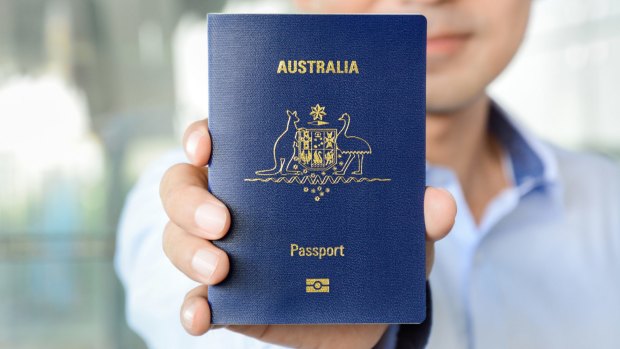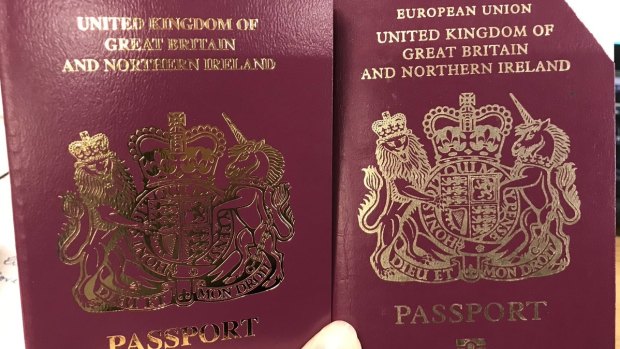This was published 4 years ago
Passport colours: Why passports only come in red, blue, green and black
By Oliver Smith

There's a reason why Australian passports, and all others, are in basic colours.Credit: iStock
Despite the myriad options available – from soft lilac to dazzling yellow – the passport of every single country on the planet sticks with one of four colours: red, blue, green and black.
Yes, there are slight variations. Switzerland's passport is scarlet, for example, while most of Europe prefers burgundy. But there's no orange, yellow, white or pink.
There are rules when it comes to passports. They must be made from a material that bends, they should be machine readable at temperatures ranging from –10C to 50C, and at relative air humidity of five to 95 per cent.

British passports are red and are now being issued without the words "European Union" on the cover despite the Brexit delay.Credit: AP
When it comes to design there are no strict regulations, only suggestions. The International Civil Aviation Organization recommends a size of 125 mm × 88 mm, and has guidance on suitable type size and font. But it says nothing regarding colour.
So why the lack of variety?
Simply put, countries stick to more conservative colours because they appear more official. Lime green and baby blue might appeal to fashion brands, but they don't tickle the fancy of sensible bureaucrats and civil servants.
Furthermore, there are political and geographical considerations when it comes to passport colour. EU countries, with the exception of Croatia, use burgundy. Perhaps it is a coincidence, but Turkey, which hopes to join the EU, changed its travel documents from black to burgundy in 2010. Britain adopted burgundy in 1988 but announced a return to blue ahead of Brexit.
Most European countries not in the EU – Switzerland, Norway and Russia, for example – also use red.
Blue is favoured by most "New World" nations. The 15 Caricom (Caribbean Community and Common Market) countries all use dark blue, as does the US, Canada, and much of South America.
Green is the colour of choice for many countries with large Muslim populations, including Saudi Arabia, Egypt, Morocco, Tunisia, Turkmenistan and Uzbekistan. It has deep associations with Islam, was supposedly the prophet Muhammad's favourite colour, and appears on many Middle Eastern and North African flags.
Black is the least common passport colour – users include Mexico, India and Algeria.
The world's coolest passports
While there is little innovation when it comes to passport colour, the same cannot be said for the pages contained within.
A security feature on the Norwegian passport, for example, displays the Northern Lights when placed under a UV light.
The inside pages of the Finnish passport contain drawings of elks and birds that when flipped rapidly show the animals in motion.
Norway's travel document isn't the only one that's transformed under a UV light. Each page of the Canadian passport bursts into life.
The world's most powerful passports
Residents of Japan and Singapore possess the world's most powerful passport, a report last month revealed, while Australia climbed one spot to from joint 10th place to joint ninth.
The quarterly ranking by Henley & Partners, a citizenship and planning firm, takes into account how many destinations can be visited without applying for a visa. Citizens of Japan and Singapore can both travel to 190 out of a possible 218, while Britons can visit 184 (down from 186 in 2018).
Along with several other nationalities, Australians lost visa-free access to Turkey and Ukraine last year, dropping the number of countries from 183 to 181.
Finland, Germany and South Korea share third place, while Denmark, Italy and Luxembourg complete the top eight. Afghanistan holds the bottom spot, with only 25 destinations accessible visa-free to their citizens (down from 30 in 2018), followed by Iraq, Syria, Somalia and Pakistan.
The UK occupied the top spot from 2013 to 2015, while Germans had the world's most powerful passport in 2016 and 2017. A raft of new visa-waiver agreements catapulted Japan and Singapore to the top of the rankings last year, but European countries still dominate: 19 of the top 25 countries are in Europe.
The Telegraph, London
See also: The 10 countries making it easier for Australians to visit
See also: The rip-off e-visa scams that are catching out Australians
Sign up for the Traveller newsletter
The latest travel news, tips and inspiration delivered to your inbox. Sign up now.